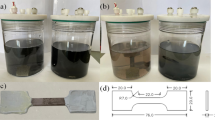Abstract
Biocides are currently the primary mitigation method to control sulfate-reducing bacteria (SRB) in biofouling, reservoir souring and microbiologically influenced corrosion. Increasingly restrictive environmental regulations and safety concerns on biocide uses demand more efficient dosing of biocides. Chelators have been known to enhance antibiotics because of their properties such as increasing the permeability of the outer cell membrane of Gram-negative bacteria. Two readily biodegradable chelators, ethylenediaminedisuccinate (EDDS) and N-(2-hydroxyethyl)iminodiacetic acid (HEIDA) disodium salts that are touted as potential replacements of ethylenediaminetetraacetic acid (EDTA), were evaluated as potential biocide enhancers for glutaraldehyde and tetrakis hydroxymethyl phosphonium sulfate (THPS) in their inhibition of planktonic SRB growth. Desulfovibrio vulgaris ATCC 7757 and Desulfovibrio desulfuricans ATCC 14563 were grown in modified ATCC 1249 medium and in enriched artificial seawater, respectively. Laboratory tests in 100 ml anaerobic vials showed that EDDS or HEIDA alone did not inhibit SRB growth. However, when EDDS or HEIDA was combined with glutaraldehyde or THPS, each of them enhanced the biocide inhibition of planktonic SRB growth.





Similar content being viewed by others
References
Atkinson M, Bingman C (1996) The composition of several synthetic seawater mixes. J Aquaric Aquat Sci 8:39–43
Ballantyne B, Jordan SL (2004) Biocides. In: Marrs TC, Ballantyne B (eds) Pesticide toxicology and international regulation. Wiley, Chichester, pp 384–385
Banin E, Brady KM, Greenberg EP (2006) Chelator-induced dispersal and killing of Pseudomonas aeruginosa cells in a biofilm. App Environ Microbial 72:2064–2069. doi:10.1128/AEM.72.3.2064-2069.2006
De Savaria SG, de Mele MFL (2005) Enhancement of glutaraldehyde biocidal efficacy by the application of an electric field. Effect on sessile cells and on cells released by the biofilm. World J Microbiol Biotechnol 21:1077–1081. doi:10.1007/s11274-004-8288-1
Denyer SP (1995) Mechanisms of action of antibacterial biocides. Int Biodeter Biodegr 36:227–245. doi:10.1016/0964-8305(96)00015-7
Dow Chemical Co., XUS40855.01 (2007) Developmental chelating agent. Available via http://www.prochem.ch/html/forum/XUS40855.01%20Data%20Sheet.pdf (a technical report). Accessed 01 Feb 2009
European Commission (2004) Edetic acid (EDTA) (CAS No: 60-00-4): European Union Risk Assessment Report vol 49. European Chemicals Bureau, Luxembourg. Available via http://ecb.jrc.ec.europa.eu/documents/Existing-Chemicals/RISK_ASSESSMENT/REPORT/edtareport061.pdf. Accessed 01 Feb 2009
Fernance N, Farinha PA, Javaherdashti A (2007) SRB-assisted MIC of fire sprinkler piping. Mater Performance 46(2):46–49
Flemming HC (1996) Economical and technical overview. In: Heitz E, Flemming HC, Sand W (eds) Microbially influenced corrosion of materials. Springer, Berlin, pp 5–14
Gardner LR, Stewart PS (2002) Action of glutaraldehyde and nitrite against sulfate-reducing bacterial biofilms. J Ind Microbiol Biotechnol 29:354–360. doi:10.1038/sj.jim.7000284
Greene EA, Brunelle V, Jenneman GE, Voordouw G (2006) Synergistic inhibition of microbial sulfide production by combinations of the metabolic inhibitor nitrite and biocides. App Environ Microbial 72:7897–7901. doi:10.1128/AEM.01526-06
Hubert C, Voordouw G (2007) Oil field souring control by nitrate-reducing Sulfurospirillum spp. that outcompete sulfate-reducing bacteria for organic electron donors. Appl Environ Microbiol 73:2644–2652. doi:10.1128/AEM.02332-06
Jaworska JS, Schowanek D, Feijtel TCJ (1999) Environmental risk assessment for trisodium [S, S]-ethylene diamine disuccinate, a biodegradable chelator used in detergent applications. Chemosphere 38:3597–3625. doi:10.1016/S0045-6535(98)00573-6
Laopaiboon L, Phukoetphim N, Laopaiboon P (2006) Effect of glutaraldehyde biocide on laboratory-scale rotating biological contactors and biocide efficacy. Electron J Biotechnol 9:358–369. doi:10.2225/vol9-issue4-fulltext-10
Poulton WIJ, Cloete TE, von Holy A (1995) Microbiological survey of open recirculating cooling water systems and their raw water supplies at twelve fossil-fired power stations. Water SA 21:357–364
Raad I, Sherertz R (2001) Chelators in combination with biocides: treatment of microbially induced biofilm and corrosion. US patent 6,267,979
Raad I, Chatzinikolaou I, Chaiban G, Hanna H, Hachem R, Dvorak T, Cook G, Costerton W (2003) In vitro and ex vivo activities of minocycline and EDTA against microorganisms embedded in biofilm on catheter surfaces. Antimicrob Agents Chemother 47:3580–3585. doi:10.1128/AAC.47.11.3580-3585.2003
Raad I, Hanna H, Dvorak T, Chaiban G, Hachem R (2007) Optimal antimicrobial catheter lock solution, using different combinations of minocycline, EDTA, and 25-percent ethanol, rapidly eradicates organisms embedded in biofilm. Antimicrob Agents Chemother 51:78–83. doi:10.1128/AAC.00154-06
Russell AD (2002) Antibiotic and biocide resistance in bacteria: introduction. J Appl Microbiol Suppl 92:1s–3s. doi:10.1046/j.1365-2672.92.5s1.14.x
Schowanek D, Feijtel TCJ, Perkins CM, Hartman FA, Federle TW, Larson RJ (1997) Biodegradation of [S, S], [R, R] and mixed stereoisomers of ethylene diamine disuccinic acid (EDDS), a transition metal chelator. Chemosphere 34:2375–2391. doi:10.1016/S0045-6535(97)00082-9
Tator KB (2003) Preventing hydrogen sulfide and microbiologically influenced corrosion in wastewater facilities. Mater Performance 42(7):32–37
Vaara M (1992) Agents that increase the permeability of the outer membrane. Microbiol Rev 56:395–411
Vance I, Thrasher DR (2005) Reservoir souring: mechanism and prevention. In: Ollivier B, Magot M (eds) Petroleum microbiology. ASM Press, Washington, DC, pp 123–142
Videla HA (1996) Manual of biocorrosion. CRC Press, Boca Raton
Von Rege H, Sand W (1998) Evaluation of biocide efficacy by microcalorimetric determination of microbial activity in biofilms. J Microbiol Methods 33:227–235. doi:10.1016/S0167-7012(98)00055-4
Wagner D, Chamberlain AHL (1997) Microbiologically influenced copper corrosion in potable water with emphasis on practical relevance. Biodegradation 8:177–187. doi:10.1023/A:1008206918628
Acknowledgments
This work was supported by a grant from Enhanced Corrosion Prevention, LLC, and a seed grant from the M. D. Anderson Cancer Center.
Author information
Authors and Affiliations
Corresponding author
Rights and permissions
About this article
Cite this article
Wen, J., Zhao, K., Gu, T. et al. Chelators enhanced biocide inhibition of planktonic sulfate-reducing bacterial growth. World J Microbiol Biotechnol 26, 1053–1057 (2010). https://doi.org/10.1007/s11274-009-0269-y
Received:
Accepted:
Published:
Issue Date:
DOI: https://doi.org/10.1007/s11274-009-0269-y




